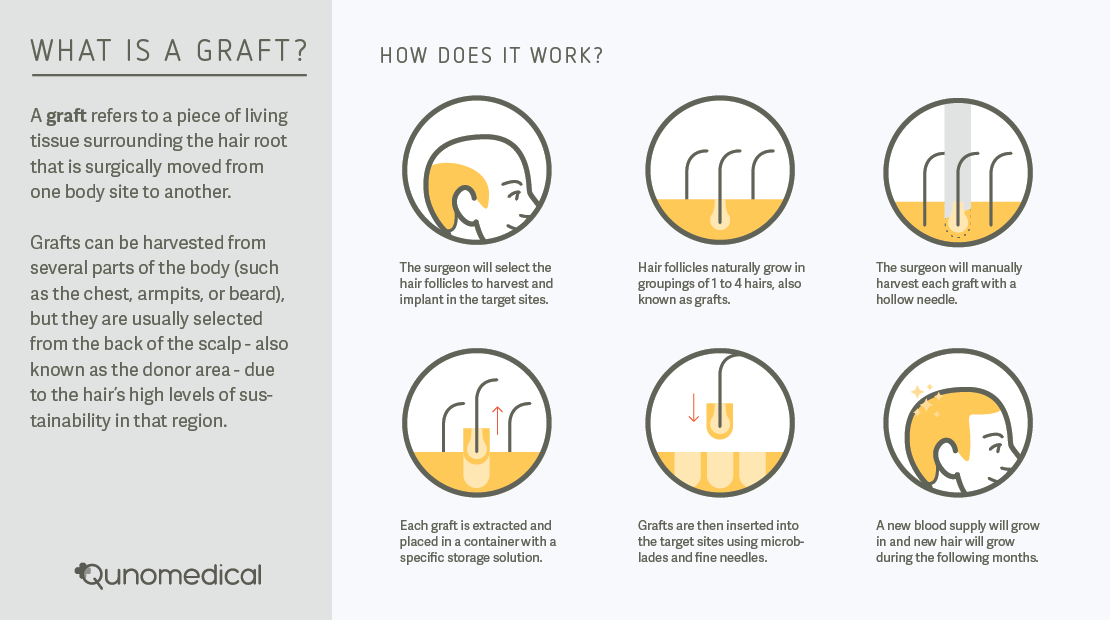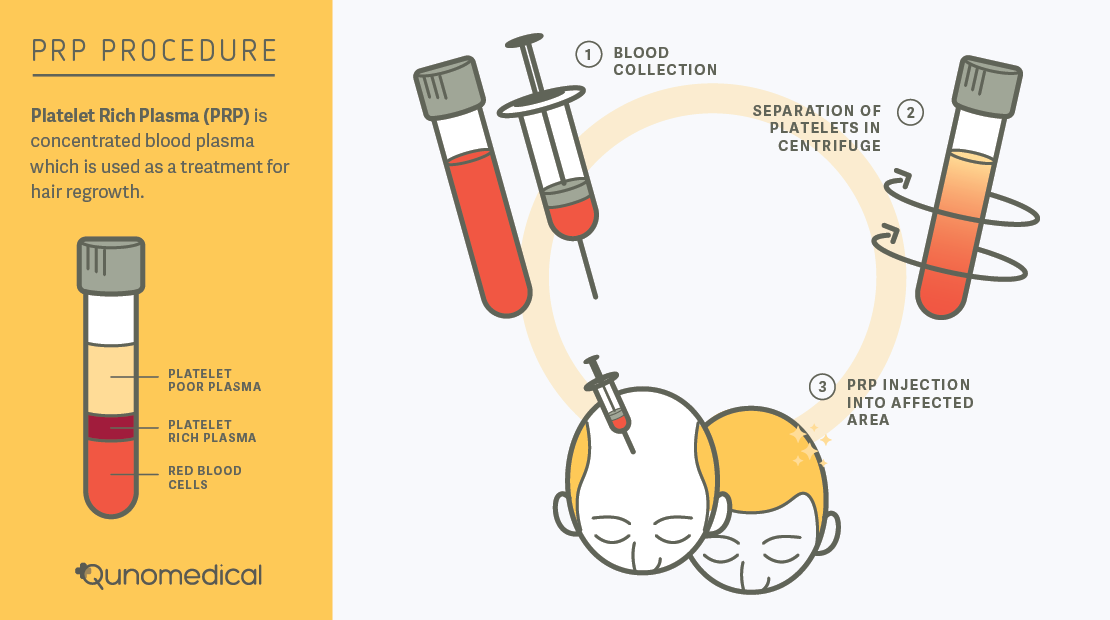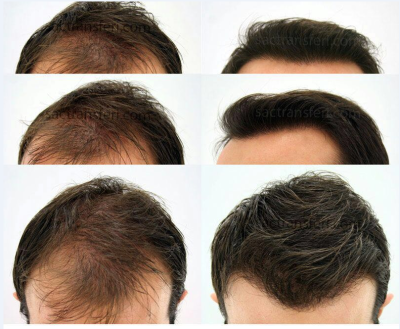In this guide we provide answers to the most common questions asked by those considering hair transplant surgery. We give you an overview of how the procedure actually works, what kind of results to expect and what you should pay attention to in order to minimise the potential risks associated with hair transplants.
Qunomedical makes it easy to find information, book treatments, and reach world renowned doctors.
What is a hair transplant?
A hair transplant is a minimally-invasive, outpatient surgical procedure that can permanently restore the hair of men and women who are experiencing partial baldness by transplanting new follicles into balding or thinning areas.
Who is eligible for a hair transplant?
A hair transplant can be recommended for anyone experiencing partial baldness due to male-pattern baldness (androgenic alopecia), female-pattern baldness, a receding hairline, traction alopecia, or head trauma. A hair transplant can offer eligible candidates a permanent, natural-looking solution.
The procedure is not recommended for anyone experiencing diffuse hair loss (chronic telogen effluvium), spot baldness (alopecia areata), or for those with insufficient hair at the donor site. The surgery is also not generally recommended for anyone under the age of 25, since it is difficult to assess the long-term stability of donor hair and the extent of future hair loss.

How is a hair transplant performed?
There are two treatment methods used by hair transplant surgeons today, Follicular Unit Extraction (FUE) and Follicular Unit Transplantation (FUT).
Follicular Unit Transplantation (also known as: FUT, Follicular Unit Strip Surgery, Strip Harvesting)
The traditional technique, developed in the 1950s, involves a surgeon removing a strip of skin from the donor area (usually the back of the patient’s head) under local anesthesia, dividing it into smaller grafts, and then implanting them into place on the recipient sites.
With this method, the patient has a permanent scar in the place where the scalp was removed, and recovery time is around 2 weeks.
Follicular Unit Extraction (also known as: FUE, FUE harvesting)
Increasingly more popular, as it is much less invasive and has minimal downtime, the FUE method involves a surgeon manually harvesting individual hair follicles from a donor area under local anesthesia, and then grafting them into the appropriate places to achieve a natural, uniform look.
With this technique, the donor area is usually shaved down (although there are surgeons that utilise the no-shave technique), and healing takes place in under 5 days.
What is a graft?
A graft refers to a piece of living tissue that is surgically moved from one body site to another, without bringing its own blood supply with it. After it is placed into the target site, a new blood supply will grow in.
Hair follicles naturally grow in groupings of 1 to 4 hairs, known as follicular units. FUE hair transplant surgeons will aim to harvest and transplant hairs in their natural groupings to promote uniform hair growth. The surgeon will harvest each follicular unit (graft) with a hollow needle between .6mm and 1.0mm in diameter. Then, the surgeon will use microblades and fine needles to insert the grafts into the target sites, angling the grafts in a consistent pattern for a natural look and density.

What is PRP treatment?
Platelet-rich plasma therapy (PRP) is a generally accepted supplement to hair transplants, to promote hair growth and healing after the surgical procedure.
PRP is a natural derivative from blood, dense with nutrients and growth factors. Platelet cells promote healing, accelerate the rate of soft tissue regeneration, enhance responses to injury, and stimulate stem cells for the formation of new cell growths.
To obtain the PRP, blood is drawn from the patient and centrifuged twice, to separate the red blood cells from the platelets. The platelet cells are then concentrated into a jelly-like plasma, at 3 to 5 times the concentration normally found. The PRP can then be injected or applied topically during or after the surgical procedure.

How long does a hair transplant take?
The length of the procedure itself varies, based on the number of hair grafts required and the size of the surgical team, but is usually completed in 4 to 8 hours. Because the procedure is done under local anesthesia, the patient is fully awake and can read, watch TV, have conversations, eat, etc., during this time.
Immediately following the procedure, patients can walk around and resume the majority of their normal day-to-day activities. The transplanted area will be swollen and tender for 3 to 5 days, but patients can return to work within 2 to 3 days of the hair transplant. There will usually be redness and scabs for up to 10 to 14 days post-procedure.
Some patients may require that the hair transplant be performed in multiple sessions, a few months apart, to achieve the desired result. This can be determined by the surgeon before the procedure.
What kind of results can be expected from a hair transplant?
Within the first 2 to 3 weeks after the hair transplant, all of the transplanted hair will fall out. This phenomenon is known as ‘Shock Loss’, and is a normal result of the trauma that the moved hair follicles have undergone. Some patients may also experience hair loss from areas that were not involved in the transplant--this is temporary and normal.
Within 6 to 8 weeks after the surgical procedure, 85% to 95% of the transplanted follicles should start generating new hair growth, with more hair and thicker growths coming in after every growth cycle (each growth cycle is around 6 weeks, depending on the individual). Although results will be visible by the 6-month mark, the full scope of the hair transplant will occur 12 months after the procedure.
For optimal results, patients are encouraged to carefully follow the surgeon’s post-operative care guidelines, including protecting the area from sun exposure, not scratching the scalp, and shampooing regularly to prevent scabs from forming around the hair shaft. Most surgeons also recommend minimizing alcohol consumption and smoking in the weeks following the procedure, as this can contribute to poor graft survival.
Is one hair transplant surgery enough to achieve full coverage?
The number of grafts that is usually harvested in a single session is up to 5000. A single transplant is usually designed to be a stand-alone procedure but a second procedure can enhance the results of the first one. People usually decide to go for a second hair transplant surgery in order to achieve more density or more coverage. It is estimated that 1 in 2 people goes back for a second surgery after one year from the first hair transplant.

What are the risks of a hair transplant?
Hair Transplantation is a simple, minimally invasive, and comparably low-risk medical procedure. However, as with any surgical procedure, there are risks associated and potential side effects, which may include bleeding, infection, swelling of the scalp and/or forehead, scarring, and uneven hair growth. Over 95% of hair transplant patients do not experience any postoperative issues.
To minimise any postoperative complications, patients are advised to select an experienced hair transplant surgeon and to follow all recommended care. Most surgeons will prescribe antibiotics or anti-inflammatories to prevent infections post-procedure, and will recommend bandage compresses be worn to alleviate scalp tenderness.
Are there other areas of the body where a hair transplant can be performed?
Yes! Hair transplants can be performed on the beard area, eyebrows, eyelashes, chest, abdomen, and pubic area. Hair transplants can also be used to fill in scars.
For a facial hair transplant or a body hair transplant, the surgeon will need to evaluate the consistency of the hair in the recipient area and match it to an area of the body with a suitable donor site for the most natural look.
How much does a hair transplant cost?
The cost of a hair transplant depends on the number of grafts required for each individual, and where the procedure is performed. The pricing differential between countries is usually due to different living costs and labor costs, rather than quality.
Below are average prices across countries for a 2000 graft hair transplant utilising the FUE method at a high-quality hospital.
For a complete cost overview, check out our Hair Transplant Cost Guide!

I want a hair transplant - What’s next?
You’ve come to the right place! At Qunomedical, your health and happiness are our top priorities, and we intend to prove that to you.
The next step is to contact us for a complimentary consultation, where we’ll determine your goals and eligibility for the procedure. We’ll ask you for some photos of your head so our medical experts can offer a recommendation on the number of grafts required to achieve a natural look for you. Then, once you decide on where you’d like to go for your hair transplant, we’ll do the legwork to get you the best price possible at the world’s leading hair transplant facilities.
Who is Qunomedical?
With Qunomedical, you can be sure that you’ll get the best quality at the most affordable prices.
We’re an independent company that knows the market inside-out, and we offer you complete transparency because unlike other medical tourism platforms, we work for you, not the hospitals. We only show you the hospitals that we’ve carefully hand-selected based on strict quality criteria, so that you don’t have to browse through massive amounts of information in order to find the best hospital for your treatment.
Regardless of what hospital or treatment you choose, we’re with you throughout every step of your journey: during the booking process, during the hospital visit, and during your recuperation period.
Where are the hair transplants performed?
You can find the clinics we partner with worldwide here.
STILL UNDECIDED? HERE'S WHAT TO READ NEXT:
Is Hair Transplant Surgery Right For Me? Hair Transplant: Is Full Coverage Possible?
Disclaimer
The information in this article is for educational purposes only and does not replace medical advice. Always consult your doctor before starting any treatments.
Find the Right Specialist at a Fraction of the Cost
Qunomedical only lists clinics and doctors that have been thoroughly vetted with quality and affordability in mind. Contact us for your 100% free, non-binding assessment.